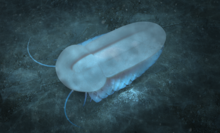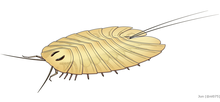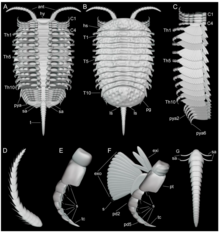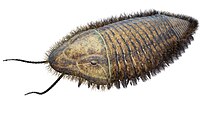Artiopoda
| Artiopoda Temporal range:
| |
|---|---|

| |
| Misszhouia,anektaspid | |

| |
| Cheloniellon,acheloniellid | |
| Scientific classification | |
| Domain: | Eukaryota |
| Kingdom: | Animalia |
| Phylum: | Arthropoda |
| (unranked): | †Artiopoda Houand Bergstrom, 1997 |
| Subgroupings | |
| |
TheArtiopodais a grouping of extinct arthropods that includestrilobitesand their close relatives. It was erected by Hou and Bergström in 1997[3]to encompass a wide diversity of arthropods that would traditionally have been assigned to the Trilobitomorpha. Trilobites, in part due to abundance of findings owing to their mineralized exoskeletons, are by far the best recorded, diverse, and long lived members of the clade. Other members, which lack mineralised exoskeletons, are known mostly fromCambriandeposits.[4]
Description
[edit]
According to Stein and Selden (2012) artiopods are recognised by the possession offiliformantennulae,limbswith bilobateexopods,with the proximal lobe being elongate and bearing a lamella, while the distal lobe is paddle-shaped andsetiforous(bearing hair-or bristle like structures). The limbendopodhas sevenpodomeres/segments, with first four podomeres bearing inward facing (endite) structures, while podomeres five and six are stenopodous (cylindrical and stout). Commonplesiomorphiesalso include the antennules and at least three sets of post-antennular limbs being incorporated into the head shield, the postantennular limbs having no or little differentiation into distinct morphologies, and broad paratergal folds which contribute to thedorsoventrallyflattened look of artiopods.[5]The limbs of artiopods have also been suggested to bearexites,which were described as similar those of themegacheiranLeanchoiliaand probably nothomologousto those present in crustaceans.[6]
Taxonomy
[edit]Internal taxonomy
[edit]The Artiopoda have been considered by many studies to consist of two major clades; one reusing Trilobitomorpha to encompass trilobites,nektaspids,concilitergans and xandarellids, and the other called Vicissicaudata encompassingaglaspidids,xenopodsandcheloniellids.[7]There are some taxa, such asSquamaculaand the members of "Protosutura", which often are placed near the base of Artiopoda, outside the Vicissicaudata+Trilobitomorpha clade. These relationships are not always recovered.[8]
Relationships with other arthropods
[edit]The relationship of Artiopoda with the two major clades of modern arthropods, theChelicerataand theMandibulata,are unresolved, with some phylogenies recovering Artiopoda as more closely to chelicerates, forming the cladeArachnomorpha,while others recover Artiopoda as more closely related to mandibulates, forming the cladeAntennulata.[9]Some studies place them as stem-group euarthropods, with mandibulates and chelicerates more closely related to each other than either is to Artiopoda.[8]Some studies have recovered a close relationship withMarrellomorpha,with the proposed clade including Artiopoda and Marrellomorpha dubbedLamellipedia,though this relationship is not found in other analyses.[10][11]The Enigma tic artiopodan-like arthropodKiisortoqia,which bears large "frontal appendages" has been suggested to be closely related to Artiopoda in some analyses.[8]
Gallery
[edit]-
Restoration of the trilobiteTriarthrus eatoni
-
Fossils ofNaraoiacompacta(Nektaspida)
-
Life restoration ofSidneyia(Vicissicaudata)
-
Diagram ofSinoburius(Xandarellida)
Phylogeny
[edit]After Jiao et al. 2021.[12]
References
[edit]- ^Liu, Cong; Fu, Dongjing; Wu, Yu; Zhang, Xingliang (July 2024)."Cambrian euarthropod Urokodia aequalis sheds light on the origin of Artiopoda body plan"(PDF).iScience:110443.doi:10.1016/j.isci.2024.110443.
- ^abZhu, Y.; Zeng, H.; Liu, Y.; Zhao, F. (2023)."New artiopodan euarthropods from the Cheng gian g fauna (Cambrian, Stage 3) at Malong, Yunnan, China".Acta Palaeontologica Polonica.68.doi:10.4202/app.01080.2023.
- ^Hou, X. & Bergström, J. 1997. Arthropods of the Lower Cambrian Cheng gian g fauna, southwest China. Fossils and Strata, No. 45. Scandinavian University Press, Oslo, 22 Dec 1997: 116 pp.[1]
- ^Schmidt, Michel; Hou, Xianguang; Zhai, Dayou; Mai, Huijuan; Belojević, Jelena; Chen, Xiaohan; Melzer, Roland R.; Ortega-Hernández, Javier; Liu, Yu (2021-08-19)."Before trilobite legs:Pygmaclypeatus daziensisreconsidered and the ancestral appendicular organization of Cambrian artiopods ".bioRxiv.doi:10.1101/2021.08.18.456779.Retrieved2022-07-29.
- ^Stein, Martin; Selden, Paul A. (June 2012). "A restudy of the Burgess Shale (Cambrian) arthropod Emeraldella brocki and reassessment of its affinities".Journal of Systematic Palaeontology.10(2): 361–383.doi:10.1080/14772019.2011.566634.ISSN1477-2019.S2CID55018927.
- ^Liu, Yu; Edgecombe, Gregory D.; Schmidt, Michel; Bond, Andrew D.; Melzer, Roland R.; Zhai, Dayou; Mai, Huijuan; Zhang, Maoyin; Hou, Xianguang (2021-07-30)."Exites in Cambrian arthropods and homology of arthropod limb branches".Nature Communications.12(1): 4619.doi:10.1038/s41467-021-24918-8.ISSN2041-1723.PMC8324779.PMID34330912.
- ^Ortega-Hernández, Javier; Legg, David A.; Braddy, Simon J. (February 2013). "The phylogeny of aglaspidid arthropods and the internal relationships within Artiopoda".Cladistics.29(1): 15–45.doi:10.1111/j.1096-0031.2012.00413.x.PMID34814371.S2CID85744103.
- ^abcBerks, H. O.; Lunde Nielsen, M.; Flannery‐Sutherland, J.; Thorshøj Nielsen, A.; Park, T.‐Y. S.; Vinther, J. (2023)."A possibly deep branching artiopodan arthropod from the lower Cambrian Sirius Passet Lagerstätte (North Greenland)".Papers in Palaeontology.9(3).doi:10.1002/spp2.1495.
- ^Aria, Cédric (2022-04-26)."The origin and early evolution of arthropods".Biological Reviews.97(5): 1786–1809.doi:10.1111/brv.12864.ISSN1464-7931.PMID35475316.S2CID243269510.
- ^Moysiuk, Joseph; Izquierdo-López, Alejandro; Kampouris, George E.; Caron, Jean-Bernard (July 2022)."A new marrellomorph arthropod from southern Ontario: a rare case of soft-tissue preservation on a Late Ordovician open marine shelf".Journal of Paleontology.96(4): 859–874.doi:10.1017/jpa.2022.11.ISSN0022-3360.
- ^Stein, Martin (November 2013)."Cephalic and appendage morphology of the Cambrian arthropod Sidneyia inexpectans".Zoologischer Anzeiger - A Journal of Comparative Zoology.253(2): 164–178.doi:10.1016/j.jcz.2013.05.001.
- ^Jiao, De-Guang; Du, Kun-Sheng; Zhang, Xi-Guang; Yang, Jie; Eggink, Daniel (May 2022)."A new small soft-bodied non-trilobite artiopod from the Cambrian Stage 4 Guanshan Biota".Geological Magazine.159(5): 730–734.doi:10.1017/S0016756821001254.ISSN0016-7568.









